GTPA Report: Analyzing Teaching Practices and Student Data
VerifiedAdded on 2023/01/06
|16
|6417
|100
Project
AI Summary
This GTPA report comprehensively analyzes a pre-service teacher's performance, focusing on five key practices: planning using data, teaching and learning, assessment (formative and summative), reflecting on teaching, and appraising the impact of teaching. The report examines the interpretation and use of various data sources, including whole-class and individual student data, to inform lesson planning and differentiate instruction. It delves into the analysis of formative data to identify opportunities for decision-making that meet students' diverse learning needs. The report also assesses the teacher's ability to provide effective feedback, grade student work, and moderate assessments. Furthermore, it reflects on teaching and assessment decisions, considering intended changes and next-step teaching strategies. The report concludes by appraising the impact of teaching practices, including the use of specific examples from a provided data scenario. The analysis considers the learning needs of three focus students, each with unique characteristics and academic requirements. This report showcases the ability of the pre-service teacher to integrate academic knowledge with practical classroom experience, aligning with the Australian Professional Standards for Teachers at a Graduate Level. The report emphasizes student-centered approaches and data-driven decision-making in the classroom.
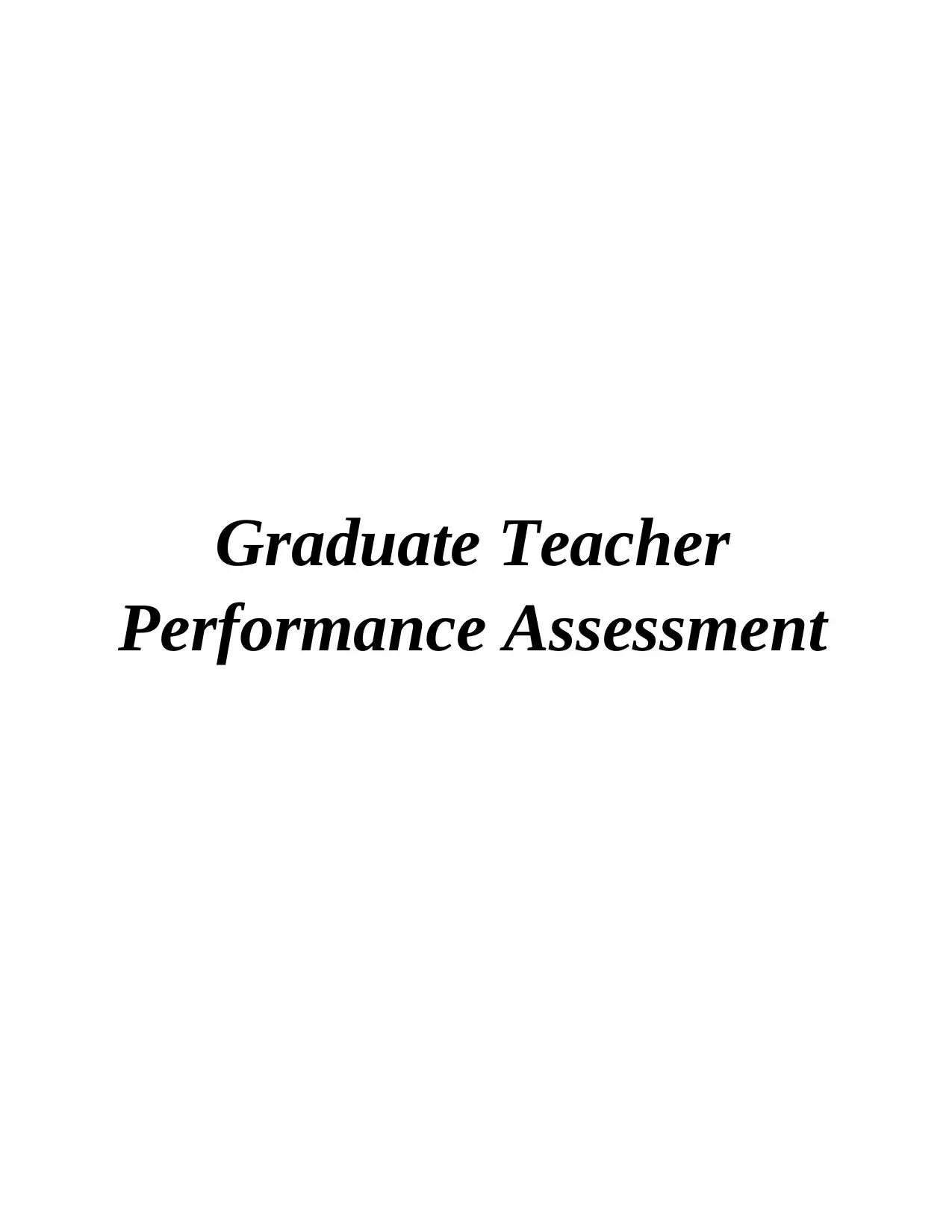
Graduate Teacher
Performance Assessment
Performance Assessment
Paraphrase This Document
Need a fresh take? Get an instant paraphrase of this document with our AI Paraphraser
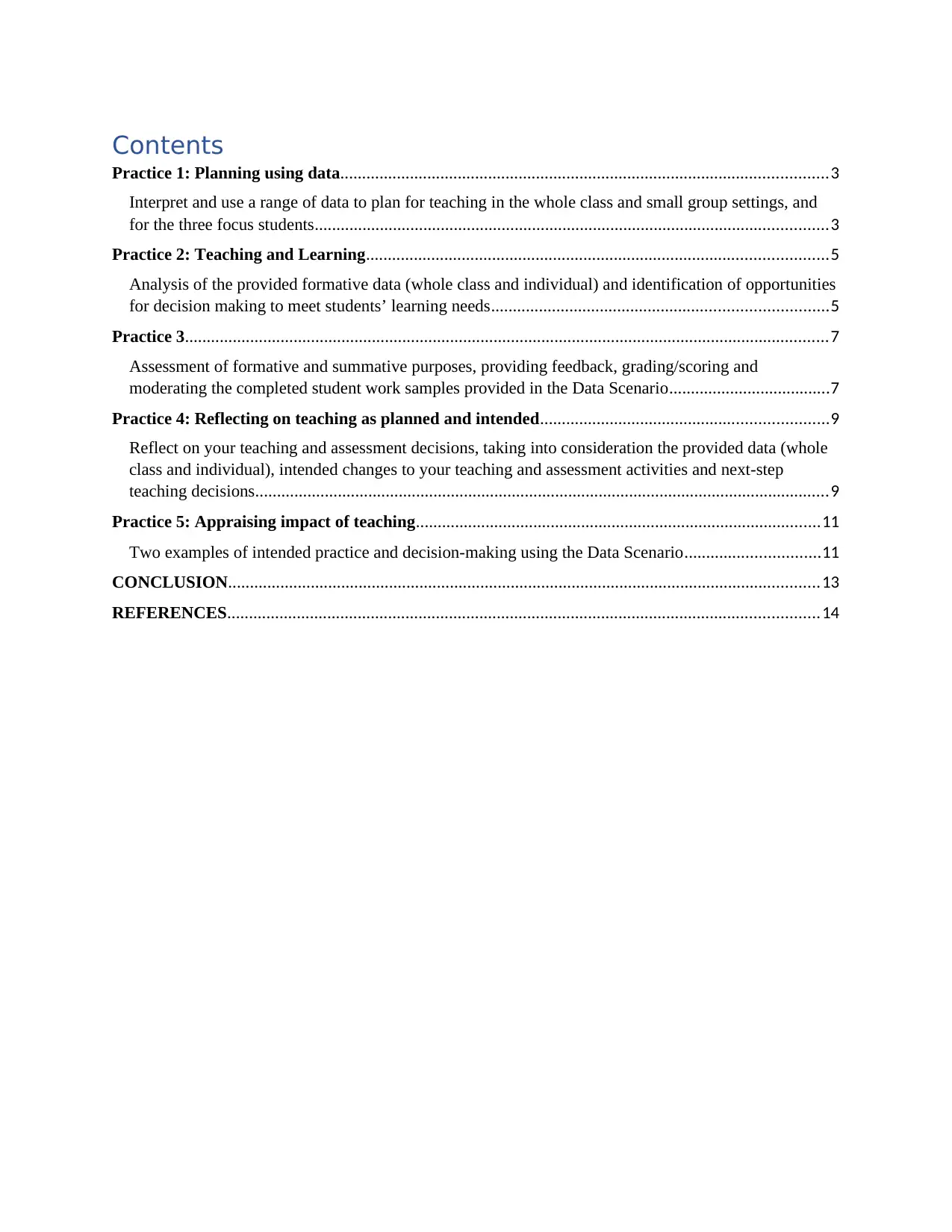
Contents
Practice 1: Planning using data................................................................................................................3
Interpret and use a range of data to plan for teaching in the whole class and small group settings, and
for the three focus students......................................................................................................................3
Practice 2: Teaching and Learning..........................................................................................................5
Analysis of the provided formative data (whole class and individual) and identification of opportunities
for decision making to meet students’ learning needs.............................................................................5
Practice 3....................................................................................................................................................7
Assessment of formative and summative purposes, providing feedback, grading/scoring and
moderating the completed student work samples provided in the Data Scenario.....................................7
Practice 4: Reflecting on teaching as planned and intended..................................................................9
Reflect on your teaching and assessment decisions, taking into consideration the provided data (whole
class and individual), intended changes to your teaching and assessment activities and next-step
teaching decisions....................................................................................................................................9
Practice 5: Appraising impact of teaching.............................................................................................11
Two examples of intended practice and decision-making using the Data Scenario...............................11
CONCLUSION........................................................................................................................................13
REFERENCES........................................................................................................................................14
Practice 1: Planning using data................................................................................................................3
Interpret and use a range of data to plan for teaching in the whole class and small group settings, and
for the three focus students......................................................................................................................3
Practice 2: Teaching and Learning..........................................................................................................5
Analysis of the provided formative data (whole class and individual) and identification of opportunities
for decision making to meet students’ learning needs.............................................................................5
Practice 3....................................................................................................................................................7
Assessment of formative and summative purposes, providing feedback, grading/scoring and
moderating the completed student work samples provided in the Data Scenario.....................................7
Practice 4: Reflecting on teaching as planned and intended..................................................................9
Reflect on your teaching and assessment decisions, taking into consideration the provided data (whole
class and individual), intended changes to your teaching and assessment activities and next-step
teaching decisions....................................................................................................................................9
Practice 5: Appraising impact of teaching.............................................................................................11
Two examples of intended practice and decision-making using the Data Scenario...............................11
CONCLUSION........................................................................................................................................13
REFERENCES........................................................................................................................................14

INTRODUCTION
Graduate Teacher Performance Assessment or GTPA can be referred to as an integrated
assessment that connects the academic program as well as professional experience. The
assessment takes place during the final year and provides an understanding of the level of
competence of the Pre-Service Teacher or PST inn a classroom setting (Afflerbach, 2017). The
assessment also provides an insight into the ability of the teacher to meet the Australian
Professional Standards for Teachers at a Graduate Level. Not only this, the assessment enables
teachers who are in their final year to demonstrate their ability to engage in the full cycle of
teaching so that there is a positive impact on the learning of students. There are different aspects
of teaching and GTPA helps in sustaining a focus on the same. The report includes explanation
of five different practices based on the interpretation of data that has been provided for three
different students.
Practice 1: Planning using data
Interpret and use a range of data to plan for teaching in the whole class and small group settings,
and for the three focus students
There are three different focus students provided in the scenario and each of them have
different characteristics as well as teaching requirements. Focus student A is a happy student
who is happy student, who is dedicated and is always engaged in learning. The student is also
able to complete the tasks assigned to her on her own without depending on anyone else. On the
other hand, Focus Student B is an outgoing girl who has achieved all Cs in most of her subjects
and is fluent in reading. But she struggles with things that have to be told to her, whereas when
she participates in tasks, she has positive outcomes academically. Lastly, Focus Student C is a
boy who is outgoing, but struggles academically (Alexander, Jang and Kankane, 2017). He has
been constantly achieving below standard along with a great difficulty in reading as well as
writing. He does not want to try and gives up, even when support is provided. He has to be called
out and reminded individually of following the instructions.
Teaching in a whole class is completely different from small group settings as well as
teaching individual students with individual learning needs. Teaching in a whole class is also
referred to as whole class instruction. In this type of teaching, the teacher provides the same
lesson to the whole class along with the same lesson regardless of individual students. The
Graduate Teacher Performance Assessment or GTPA can be referred to as an integrated
assessment that connects the academic program as well as professional experience. The
assessment takes place during the final year and provides an understanding of the level of
competence of the Pre-Service Teacher or PST inn a classroom setting (Afflerbach, 2017). The
assessment also provides an insight into the ability of the teacher to meet the Australian
Professional Standards for Teachers at a Graduate Level. Not only this, the assessment enables
teachers who are in their final year to demonstrate their ability to engage in the full cycle of
teaching so that there is a positive impact on the learning of students. There are different aspects
of teaching and GTPA helps in sustaining a focus on the same. The report includes explanation
of five different practices based on the interpretation of data that has been provided for three
different students.
Practice 1: Planning using data
Interpret and use a range of data to plan for teaching in the whole class and small group settings,
and for the three focus students
There are three different focus students provided in the scenario and each of them have
different characteristics as well as teaching requirements. Focus student A is a happy student
who is happy student, who is dedicated and is always engaged in learning. The student is also
able to complete the tasks assigned to her on her own without depending on anyone else. On the
other hand, Focus Student B is an outgoing girl who has achieved all Cs in most of her subjects
and is fluent in reading. But she struggles with things that have to be told to her, whereas when
she participates in tasks, she has positive outcomes academically. Lastly, Focus Student C is a
boy who is outgoing, but struggles academically (Alexander, Jang and Kankane, 2017). He has
been constantly achieving below standard along with a great difficulty in reading as well as
writing. He does not want to try and gives up, even when support is provided. He has to be called
out and reminded individually of following the instructions.
Teaching in a whole class is completely different from small group settings as well as
teaching individual students with individual learning needs. Teaching in a whole class is also
referred to as whole class instruction. In this type of teaching, the teacher provides the same
lesson to the whole class along with the same lesson regardless of individual students. The
⊘ This is a preview!⊘
Do you want full access?
Subscribe today to unlock all pages.

Trusted by 1+ million students worldwide
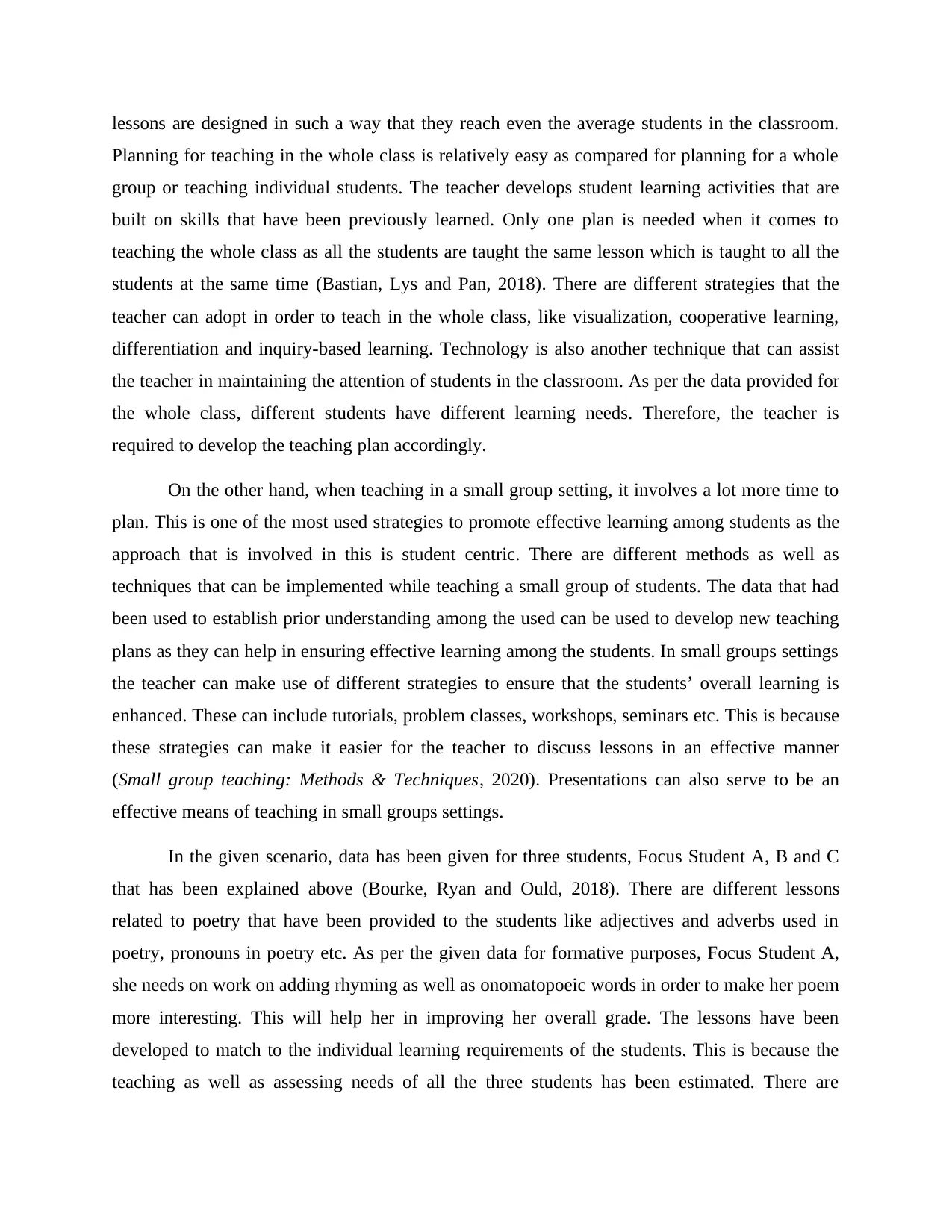
lessons are designed in such a way that they reach even the average students in the classroom.
Planning for teaching in the whole class is relatively easy as compared for planning for a whole
group or teaching individual students. The teacher develops student learning activities that are
built on skills that have been previously learned. Only one plan is needed when it comes to
teaching the whole class as all the students are taught the same lesson which is taught to all the
students at the same time (Bastian, Lys and Pan, 2018). There are different strategies that the
teacher can adopt in order to teach in the whole class, like visualization, cooperative learning,
differentiation and inquiry-based learning. Technology is also another technique that can assist
the teacher in maintaining the attention of students in the classroom. As per the data provided for
the whole class, different students have different learning needs. Therefore, the teacher is
required to develop the teaching plan accordingly.
On the other hand, when teaching in a small group setting, it involves a lot more time to
plan. This is one of the most used strategies to promote effective learning among students as the
approach that is involved in this is student centric. There are different methods as well as
techniques that can be implemented while teaching a small group of students. The data that had
been used to establish prior understanding among the used can be used to develop new teaching
plans as they can help in ensuring effective learning among the students. In small groups settings
the teacher can make use of different strategies to ensure that the students’ overall learning is
enhanced. These can include tutorials, problem classes, workshops, seminars etc. This is because
these strategies can make it easier for the teacher to discuss lessons in an effective manner
(Small group teaching: Methods & Techniques, 2020). Presentations can also serve to be an
effective means of teaching in small groups settings.
In the given scenario, data has been given for three students, Focus Student A, B and C
that has been explained above (Bourke, Ryan and Ould, 2018). There are different lessons
related to poetry that have been provided to the students like adjectives and adverbs used in
poetry, pronouns in poetry etc. As per the given data for formative purposes, Focus Student A,
she needs on work on adding rhyming as well as onomatopoeic words in order to make her poem
more interesting. This will help her in improving her overall grade. The lessons have been
developed to match to the individual learning requirements of the students. This is because the
teaching as well as assessing needs of all the three students has been estimated. There are
Planning for teaching in the whole class is relatively easy as compared for planning for a whole
group or teaching individual students. The teacher develops student learning activities that are
built on skills that have been previously learned. Only one plan is needed when it comes to
teaching the whole class as all the students are taught the same lesson which is taught to all the
students at the same time (Bastian, Lys and Pan, 2018). There are different strategies that the
teacher can adopt in order to teach in the whole class, like visualization, cooperative learning,
differentiation and inquiry-based learning. Technology is also another technique that can assist
the teacher in maintaining the attention of students in the classroom. As per the data provided for
the whole class, different students have different learning needs. Therefore, the teacher is
required to develop the teaching plan accordingly.
On the other hand, when teaching in a small group setting, it involves a lot more time to
plan. This is one of the most used strategies to promote effective learning among students as the
approach that is involved in this is student centric. There are different methods as well as
techniques that can be implemented while teaching a small group of students. The data that had
been used to establish prior understanding among the used can be used to develop new teaching
plans as they can help in ensuring effective learning among the students. In small groups settings
the teacher can make use of different strategies to ensure that the students’ overall learning is
enhanced. These can include tutorials, problem classes, workshops, seminars etc. This is because
these strategies can make it easier for the teacher to discuss lessons in an effective manner
(Small group teaching: Methods & Techniques, 2020). Presentations can also serve to be an
effective means of teaching in small groups settings.
In the given scenario, data has been given for three students, Focus Student A, B and C
that has been explained above (Bourke, Ryan and Ould, 2018). There are different lessons
related to poetry that have been provided to the students like adjectives and adverbs used in
poetry, pronouns in poetry etc. As per the given data for formative purposes, Focus Student A,
she needs on work on adding rhyming as well as onomatopoeic words in order to make her poem
more interesting. This will help her in improving her overall grade. The lessons have been
developed to match to the individual learning requirements of the students. This is because the
teaching as well as assessing needs of all the three students has been estimated. There are
Paraphrase This Document
Need a fresh take? Get an instant paraphrase of this document with our AI Paraphraser
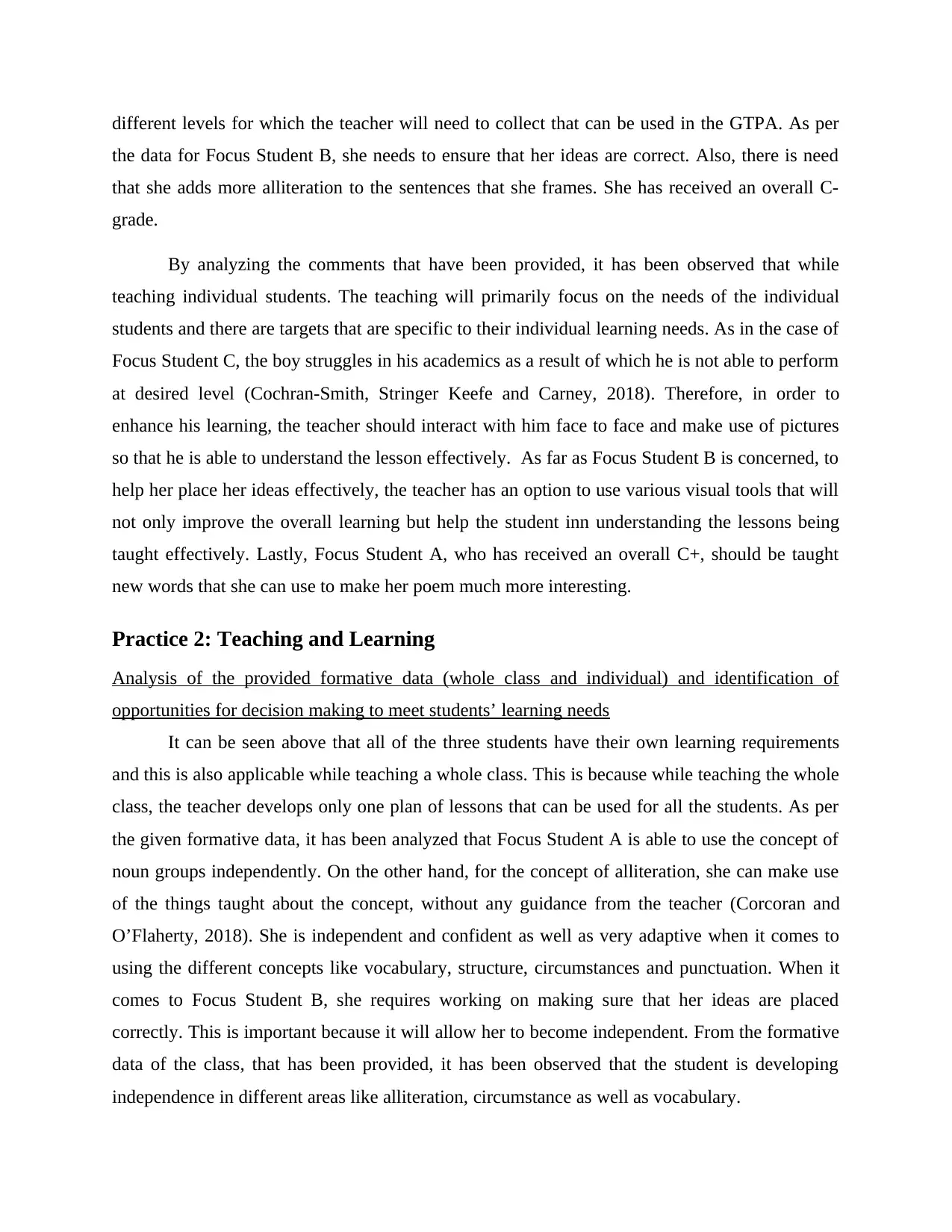
different levels for which the teacher will need to collect that can be used in the GTPA. As per
the data for Focus Student B, she needs to ensure that her ideas are correct. Also, there is need
that she adds more alliteration to the sentences that she frames. She has received an overall C-
grade.
By analyzing the comments that have been provided, it has been observed that while
teaching individual students. The teaching will primarily focus on the needs of the individual
students and there are targets that are specific to their individual learning needs. As in the case of
Focus Student C, the boy struggles in his academics as a result of which he is not able to perform
at desired level (Cochran-Smith, Stringer Keefe and Carney, 2018). Therefore, in order to
enhance his learning, the teacher should interact with him face to face and make use of pictures
so that he is able to understand the lesson effectively. As far as Focus Student B is concerned, to
help her place her ideas effectively, the teacher has an option to use various visual tools that will
not only improve the overall learning but help the student inn understanding the lessons being
taught effectively. Lastly, Focus Student A, who has received an overall C+, should be taught
new words that she can use to make her poem much more interesting.
Practice 2: Teaching and Learning
Analysis of the provided formative data (whole class and individual) and identification of
opportunities for decision making to meet students’ learning needs
It can be seen above that all of the three students have their own learning requirements
and this is also applicable while teaching a whole class. This is because while teaching the whole
class, the teacher develops only one plan of lessons that can be used for all the students. As per
the given formative data, it has been analyzed that Focus Student A is able to use the concept of
noun groups independently. On the other hand, for the concept of alliteration, she can make use
of the things taught about the concept, without any guidance from the teacher (Corcoran and
O’Flaherty, 2018). She is independent and confident as well as very adaptive when it comes to
using the different concepts like vocabulary, structure, circumstances and punctuation. When it
comes to Focus Student B, she requires working on making sure that her ideas are placed
correctly. This is important because it will allow her to become independent. From the formative
data of the class, that has been provided, it has been observed that the student is developing
independence in different areas like alliteration, circumstance as well as vocabulary.
the data for Focus Student B, she needs to ensure that her ideas are correct. Also, there is need
that she adds more alliteration to the sentences that she frames. She has received an overall C-
grade.
By analyzing the comments that have been provided, it has been observed that while
teaching individual students. The teaching will primarily focus on the needs of the individual
students and there are targets that are specific to their individual learning needs. As in the case of
Focus Student C, the boy struggles in his academics as a result of which he is not able to perform
at desired level (Cochran-Smith, Stringer Keefe and Carney, 2018). Therefore, in order to
enhance his learning, the teacher should interact with him face to face and make use of pictures
so that he is able to understand the lesson effectively. As far as Focus Student B is concerned, to
help her place her ideas effectively, the teacher has an option to use various visual tools that will
not only improve the overall learning but help the student inn understanding the lessons being
taught effectively. Lastly, Focus Student A, who has received an overall C+, should be taught
new words that she can use to make her poem much more interesting.
Practice 2: Teaching and Learning
Analysis of the provided formative data (whole class and individual) and identification of
opportunities for decision making to meet students’ learning needs
It can be seen above that all of the three students have their own learning requirements
and this is also applicable while teaching a whole class. This is because while teaching the whole
class, the teacher develops only one plan of lessons that can be used for all the students. As per
the given formative data, it has been analyzed that Focus Student A is able to use the concept of
noun groups independently. On the other hand, for the concept of alliteration, she can make use
of the things taught about the concept, without any guidance from the teacher (Corcoran and
O’Flaherty, 2018). She is independent and confident as well as very adaptive when it comes to
using the different concepts like vocabulary, structure, circumstances and punctuation. When it
comes to Focus Student B, she requires working on making sure that her ideas are placed
correctly. This is important because it will allow her to become independent. From the formative
data of the class, that has been provided, it has been observed that the student is developing
independence in different areas like alliteration, circumstance as well as vocabulary.
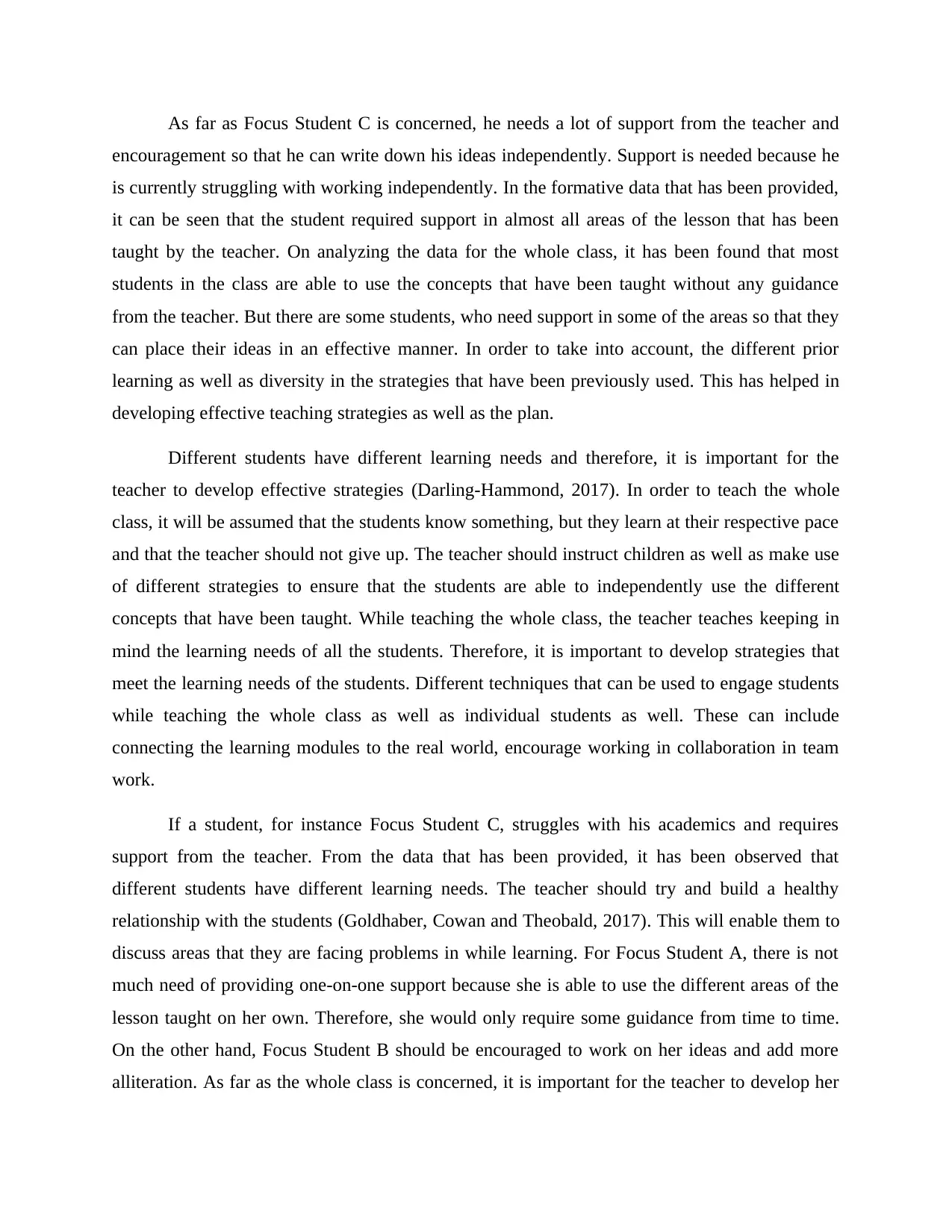
As far as Focus Student C is concerned, he needs a lot of support from the teacher and
encouragement so that he can write down his ideas independently. Support is needed because he
is currently struggling with working independently. In the formative data that has been provided,
it can be seen that the student required support in almost all areas of the lesson that has been
taught by the teacher. On analyzing the data for the whole class, it has been found that most
students in the class are able to use the concepts that have been taught without any guidance
from the teacher. But there are some students, who need support in some of the areas so that they
can place their ideas in an effective manner. In order to take into account, the different prior
learning as well as diversity in the strategies that have been previously used. This has helped in
developing effective teaching strategies as well as the plan.
Different students have different learning needs and therefore, it is important for the
teacher to develop effective strategies (Darling-Hammond, 2017). In order to teach the whole
class, it will be assumed that the students know something, but they learn at their respective pace
and that the teacher should not give up. The teacher should instruct children as well as make use
of different strategies to ensure that the students are able to independently use the different
concepts that have been taught. While teaching the whole class, the teacher teaches keeping in
mind the learning needs of all the students. Therefore, it is important to develop strategies that
meet the learning needs of the students. Different techniques that can be used to engage students
while teaching the whole class as well as individual students as well. These can include
connecting the learning modules to the real world, encourage working in collaboration in team
work.
If a student, for instance Focus Student C, struggles with his academics and requires
support from the teacher. From the data that has been provided, it has been observed that
different students have different learning needs. The teacher should try and build a healthy
relationship with the students (Goldhaber, Cowan and Theobald, 2017). This will enable them to
discuss areas that they are facing problems in while learning. For Focus Student A, there is not
much need of providing one-on-one support because she is able to use the different areas of the
lesson taught on her own. Therefore, she would only require some guidance from time to time.
On the other hand, Focus Student B should be encouraged to work on her ideas and add more
alliteration. As far as the whole class is concerned, it is important for the teacher to develop her
encouragement so that he can write down his ideas independently. Support is needed because he
is currently struggling with working independently. In the formative data that has been provided,
it can be seen that the student required support in almost all areas of the lesson that has been
taught by the teacher. On analyzing the data for the whole class, it has been found that most
students in the class are able to use the concepts that have been taught without any guidance
from the teacher. But there are some students, who need support in some of the areas so that they
can place their ideas in an effective manner. In order to take into account, the different prior
learning as well as diversity in the strategies that have been previously used. This has helped in
developing effective teaching strategies as well as the plan.
Different students have different learning needs and therefore, it is important for the
teacher to develop effective strategies (Darling-Hammond, 2017). In order to teach the whole
class, it will be assumed that the students know something, but they learn at their respective pace
and that the teacher should not give up. The teacher should instruct children as well as make use
of different strategies to ensure that the students are able to independently use the different
concepts that have been taught. While teaching the whole class, the teacher teaches keeping in
mind the learning needs of all the students. Therefore, it is important to develop strategies that
meet the learning needs of the students. Different techniques that can be used to engage students
while teaching the whole class as well as individual students as well. These can include
connecting the learning modules to the real world, encourage working in collaboration in team
work.
If a student, for instance Focus Student C, struggles with his academics and requires
support from the teacher. From the data that has been provided, it has been observed that
different students have different learning needs. The teacher should try and build a healthy
relationship with the students (Goldhaber, Cowan and Theobald, 2017). This will enable them to
discuss areas that they are facing problems in while learning. For Focus Student A, there is not
much need of providing one-on-one support because she is able to use the different areas of the
lesson taught on her own. Therefore, she would only require some guidance from time to time.
On the other hand, Focus Student B should be encouraged to work on her ideas and add more
alliteration. As far as the whole class is concerned, it is important for the teacher to develop her
⊘ This is a preview!⊘
Do you want full access?
Subscribe today to unlock all pages.

Trusted by 1+ million students worldwide
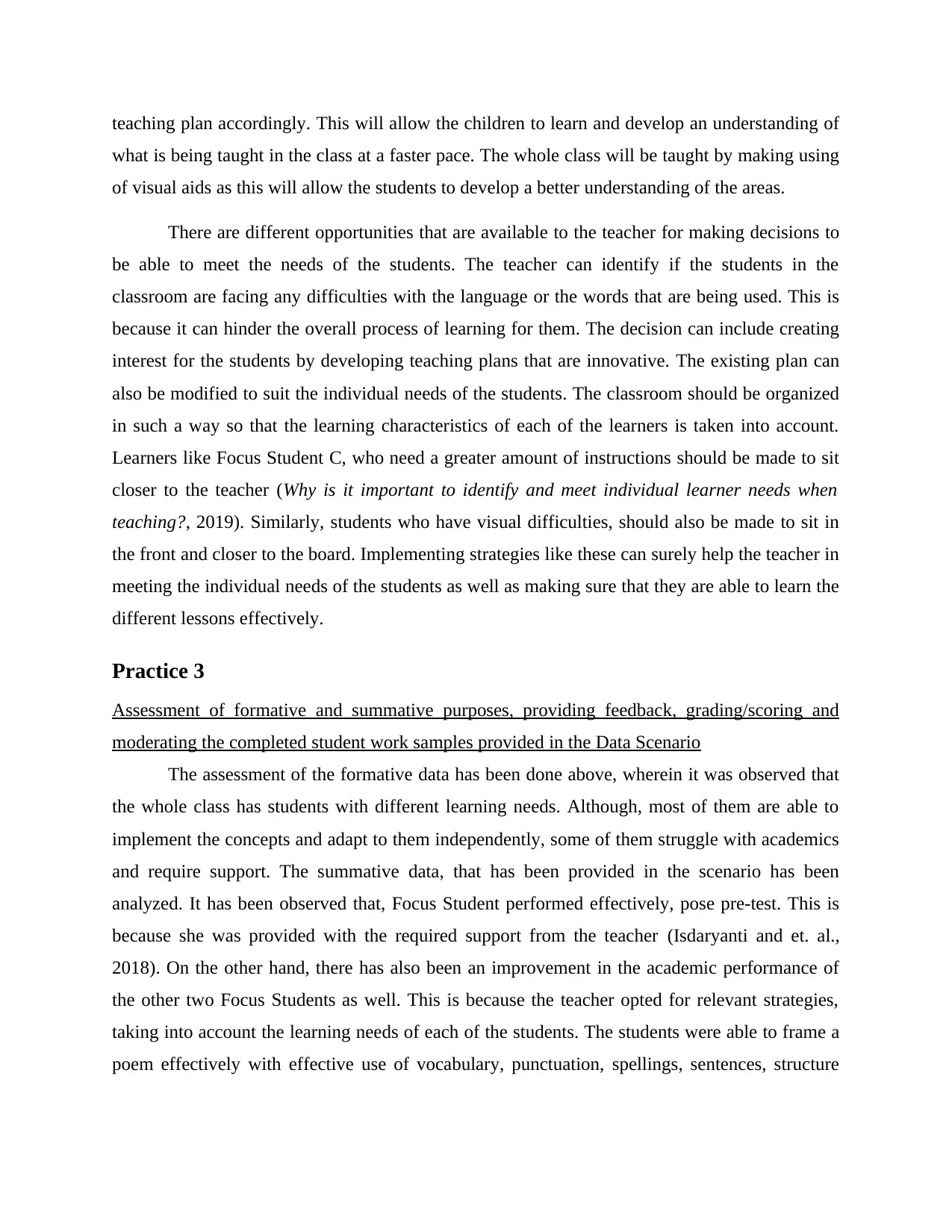
teaching plan accordingly. This will allow the children to learn and develop an understanding of
what is being taught in the class at a faster pace. The whole class will be taught by making using
of visual aids as this will allow the students to develop a better understanding of the areas.
There are different opportunities that are available to the teacher for making decisions to
be able to meet the needs of the students. The teacher can identify if the students in the
classroom are facing any difficulties with the language or the words that are being used. This is
because it can hinder the overall process of learning for them. The decision can include creating
interest for the students by developing teaching plans that are innovative. The existing plan can
also be modified to suit the individual needs of the students. The classroom should be organized
in such a way so that the learning characteristics of each of the learners is taken into account.
Learners like Focus Student C, who need a greater amount of instructions should be made to sit
closer to the teacher (Why is it important to identify and meet individual learner needs when
teaching?, 2019). Similarly, students who have visual difficulties, should also be made to sit in
the front and closer to the board. Implementing strategies like these can surely help the teacher in
meeting the individual needs of the students as well as making sure that they are able to learn the
different lessons effectively.
Practice 3
Assessment of formative and summative purposes, providing feedback, grading/scoring and
moderating the completed student work samples provided in the Data Scenario
The assessment of the formative data has been done above, wherein it was observed that
the whole class has students with different learning needs. Although, most of them are able to
implement the concepts and adapt to them independently, some of them struggle with academics
and require support. The summative data, that has been provided in the scenario has been
analyzed. It has been observed that, Focus Student performed effectively, pose pre-test. This is
because she was provided with the required support from the teacher (Isdaryanti and et. al.,
2018). On the other hand, there has also been an improvement in the academic performance of
the other two Focus Students as well. This is because the teacher opted for relevant strategies,
taking into account the learning needs of each of the students. The students were able to frame a
poem effectively with effective use of vocabulary, punctuation, spellings, sentences, structure
what is being taught in the class at a faster pace. The whole class will be taught by making using
of visual aids as this will allow the students to develop a better understanding of the areas.
There are different opportunities that are available to the teacher for making decisions to
be able to meet the needs of the students. The teacher can identify if the students in the
classroom are facing any difficulties with the language or the words that are being used. This is
because it can hinder the overall process of learning for them. The decision can include creating
interest for the students by developing teaching plans that are innovative. The existing plan can
also be modified to suit the individual needs of the students. The classroom should be organized
in such a way so that the learning characteristics of each of the learners is taken into account.
Learners like Focus Student C, who need a greater amount of instructions should be made to sit
closer to the teacher (Why is it important to identify and meet individual learner needs when
teaching?, 2019). Similarly, students who have visual difficulties, should also be made to sit in
the front and closer to the board. Implementing strategies like these can surely help the teacher in
meeting the individual needs of the students as well as making sure that they are able to learn the
different lessons effectively.
Practice 3
Assessment of formative and summative purposes, providing feedback, grading/scoring and
moderating the completed student work samples provided in the Data Scenario
The assessment of the formative data has been done above, wherein it was observed that
the whole class has students with different learning needs. Although, most of them are able to
implement the concepts and adapt to them independently, some of them struggle with academics
and require support. The summative data, that has been provided in the scenario has been
analyzed. It has been observed that, Focus Student performed effectively, pose pre-test. This is
because she was provided with the required support from the teacher (Isdaryanti and et. al.,
2018). On the other hand, there has also been an improvement in the academic performance of
the other two Focus Students as well. This is because the teacher opted for relevant strategies,
taking into account the learning needs of each of the students. The students were able to frame a
poem effectively with effective use of vocabulary, punctuation, spellings, sentences, structure
Paraphrase This Document
Need a fresh take? Get an instant paraphrase of this document with our AI Paraphraser
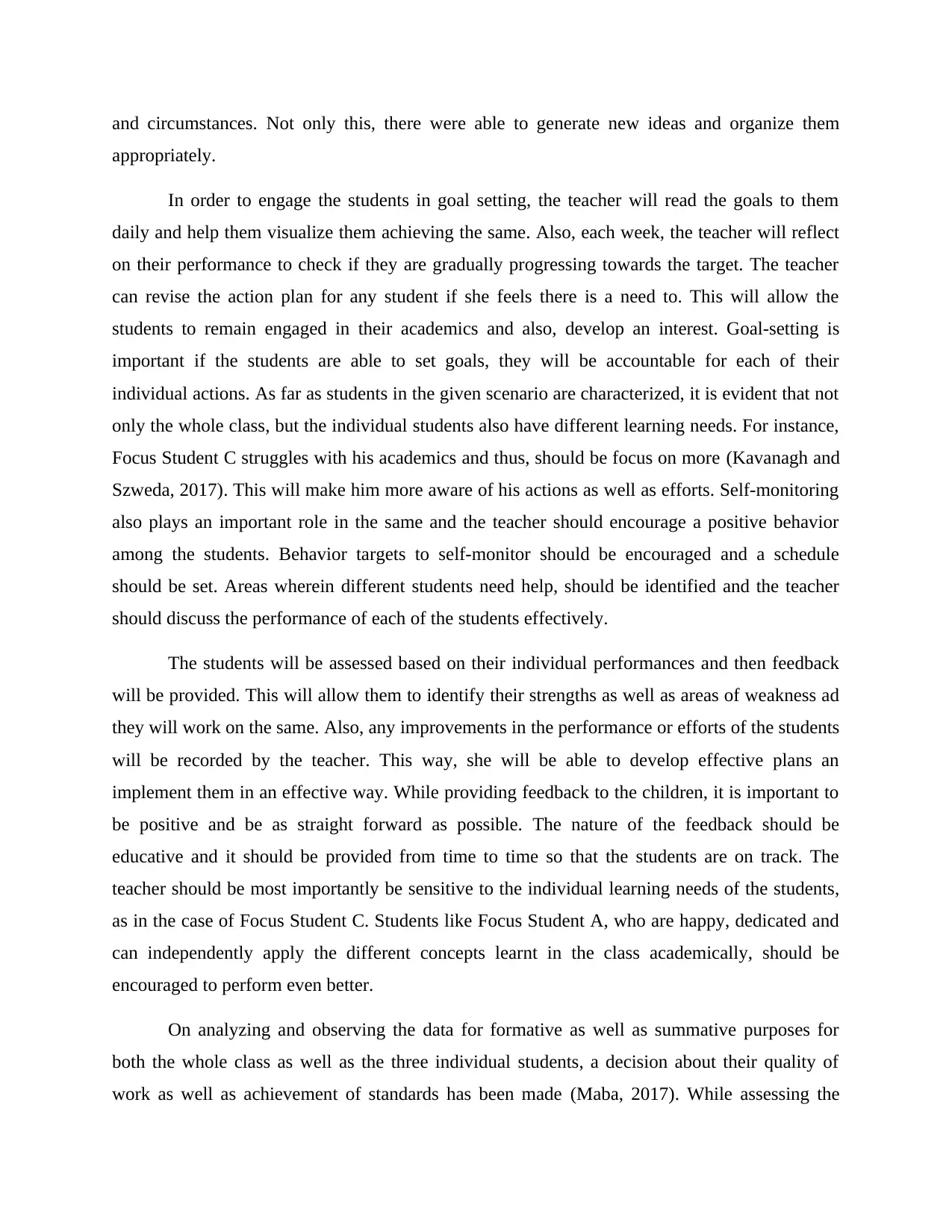
and circumstances. Not only this, there were able to generate new ideas and organize them
appropriately.
In order to engage the students in goal setting, the teacher will read the goals to them
daily and help them visualize them achieving the same. Also, each week, the teacher will reflect
on their performance to check if they are gradually progressing towards the target. The teacher
can revise the action plan for any student if she feels there is a need to. This will allow the
students to remain engaged in their academics and also, develop an interest. Goal-setting is
important if the students are able to set goals, they will be accountable for each of their
individual actions. As far as students in the given scenario are characterized, it is evident that not
only the whole class, but the individual students also have different learning needs. For instance,
Focus Student C struggles with his academics and thus, should be focus on more (Kavanagh and
Szweda, 2017). This will make him more aware of his actions as well as efforts. Self-monitoring
also plays an important role in the same and the teacher should encourage a positive behavior
among the students. Behavior targets to self-monitor should be encouraged and a schedule
should be set. Areas wherein different students need help, should be identified and the teacher
should discuss the performance of each of the students effectively.
The students will be assessed based on their individual performances and then feedback
will be provided. This will allow them to identify their strengths as well as areas of weakness ad
they will work on the same. Also, any improvements in the performance or efforts of the students
will be recorded by the teacher. This way, she will be able to develop effective plans an
implement them in an effective way. While providing feedback to the children, it is important to
be positive and be as straight forward as possible. The nature of the feedback should be
educative and it should be provided from time to time so that the students are on track. The
teacher should be most importantly be sensitive to the individual learning needs of the students,
as in the case of Focus Student C. Students like Focus Student A, who are happy, dedicated and
can independently apply the different concepts learnt in the class academically, should be
encouraged to perform even better.
On analyzing and observing the data for formative as well as summative purposes for
both the whole class as well as the three individual students, a decision about their quality of
work as well as achievement of standards has been made (Maba, 2017). While assessing the
appropriately.
In order to engage the students in goal setting, the teacher will read the goals to them
daily and help them visualize them achieving the same. Also, each week, the teacher will reflect
on their performance to check if they are gradually progressing towards the target. The teacher
can revise the action plan for any student if she feels there is a need to. This will allow the
students to remain engaged in their academics and also, develop an interest. Goal-setting is
important if the students are able to set goals, they will be accountable for each of their
individual actions. As far as students in the given scenario are characterized, it is evident that not
only the whole class, but the individual students also have different learning needs. For instance,
Focus Student C struggles with his academics and thus, should be focus on more (Kavanagh and
Szweda, 2017). This will make him more aware of his actions as well as efforts. Self-monitoring
also plays an important role in the same and the teacher should encourage a positive behavior
among the students. Behavior targets to self-monitor should be encouraged and a schedule
should be set. Areas wherein different students need help, should be identified and the teacher
should discuss the performance of each of the students effectively.
The students will be assessed based on their individual performances and then feedback
will be provided. This will allow them to identify their strengths as well as areas of weakness ad
they will work on the same. Also, any improvements in the performance or efforts of the students
will be recorded by the teacher. This way, she will be able to develop effective plans an
implement them in an effective way. While providing feedback to the children, it is important to
be positive and be as straight forward as possible. The nature of the feedback should be
educative and it should be provided from time to time so that the students are on track. The
teacher should be most importantly be sensitive to the individual learning needs of the students,
as in the case of Focus Student C. Students like Focus Student A, who are happy, dedicated and
can independently apply the different concepts learnt in the class academically, should be
encouraged to perform even better.
On analyzing and observing the data for formative as well as summative purposes for
both the whole class as well as the three individual students, a decision about their quality of
work as well as achievement of standards has been made (Maba, 2017). While assessing the
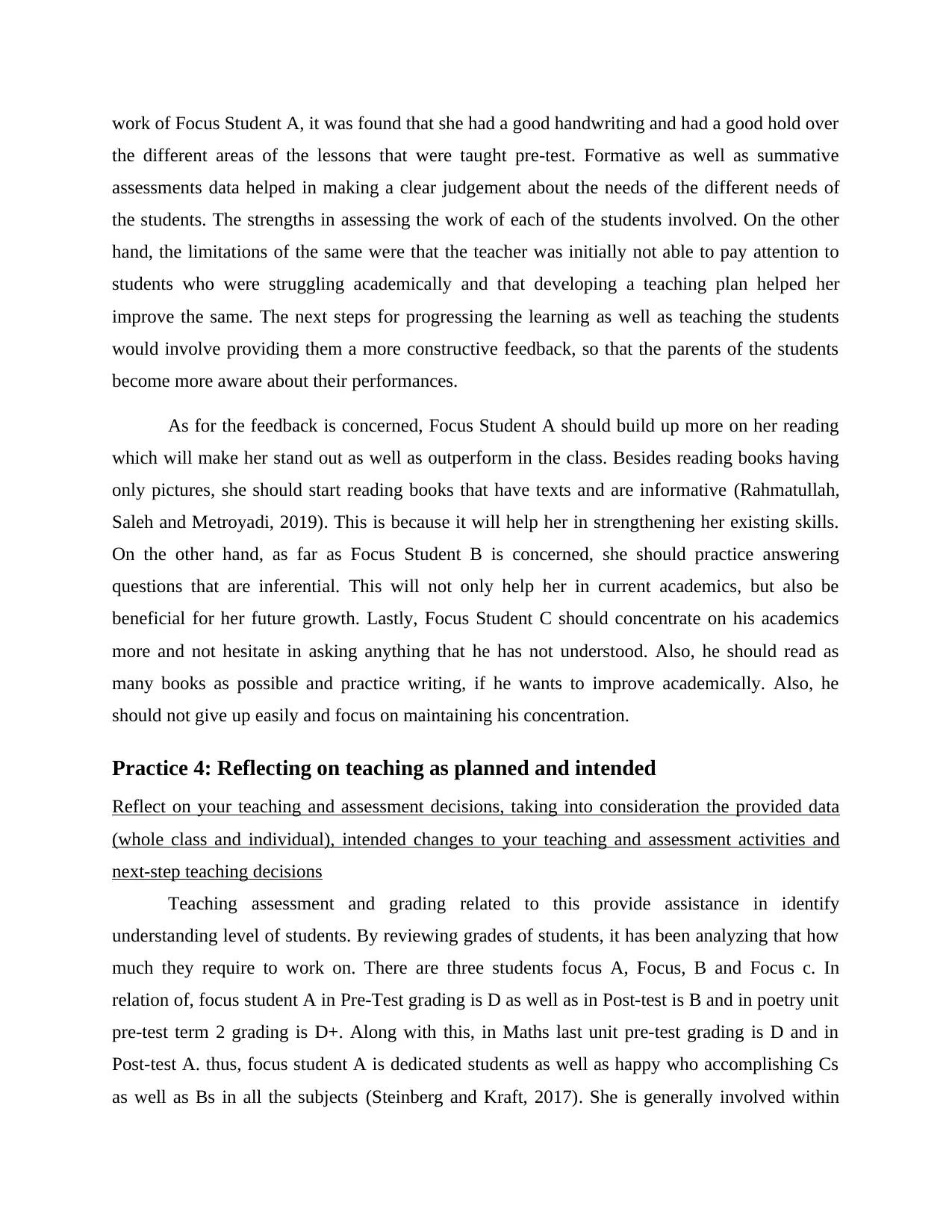
work of Focus Student A, it was found that she had a good handwriting and had a good hold over
the different areas of the lessons that were taught pre-test. Formative as well as summative
assessments data helped in making a clear judgement about the needs of the different needs of
the students. The strengths in assessing the work of each of the students involved. On the other
hand, the limitations of the same were that the teacher was initially not able to pay attention to
students who were struggling academically and that developing a teaching plan helped her
improve the same. The next steps for progressing the learning as well as teaching the students
would involve providing them a more constructive feedback, so that the parents of the students
become more aware about their performances.
As for the feedback is concerned, Focus Student A should build up more on her reading
which will make her stand out as well as outperform in the class. Besides reading books having
only pictures, she should start reading books that have texts and are informative (Rahmatullah,
Saleh and Metroyadi, 2019). This is because it will help her in strengthening her existing skills.
On the other hand, as far as Focus Student B is concerned, she should practice answering
questions that are inferential. This will not only help her in current academics, but also be
beneficial for her future growth. Lastly, Focus Student C should concentrate on his academics
more and not hesitate in asking anything that he has not understood. Also, he should read as
many books as possible and practice writing, if he wants to improve academically. Also, he
should not give up easily and focus on maintaining his concentration.
Practice 4: Reflecting on teaching as planned and intended
Reflect on your teaching and assessment decisions, taking into consideration the provided data
(whole class and individual), intended changes to your teaching and assessment activities and
next-step teaching decisions
Teaching assessment and grading related to this provide assistance in identify
understanding level of students. By reviewing grades of students, it has been analyzing that how
much they require to work on. There are three students focus A, Focus, B and Focus c. In
relation of, focus student A in Pre-Test grading is D as well as in Post-test is B and in poetry unit
pre-test term 2 grading is D+. Along with this, in Maths last unit pre-test grading is D and in
Post-test A. thus, focus student A is dedicated students as well as happy who accomplishing Cs
as well as Bs in all the subjects (Steinberg and Kraft, 2017). She is generally involved within
the different areas of the lessons that were taught pre-test. Formative as well as summative
assessments data helped in making a clear judgement about the needs of the different needs of
the students. The strengths in assessing the work of each of the students involved. On the other
hand, the limitations of the same were that the teacher was initially not able to pay attention to
students who were struggling academically and that developing a teaching plan helped her
improve the same. The next steps for progressing the learning as well as teaching the students
would involve providing them a more constructive feedback, so that the parents of the students
become more aware about their performances.
As for the feedback is concerned, Focus Student A should build up more on her reading
which will make her stand out as well as outperform in the class. Besides reading books having
only pictures, she should start reading books that have texts and are informative (Rahmatullah,
Saleh and Metroyadi, 2019). This is because it will help her in strengthening her existing skills.
On the other hand, as far as Focus Student B is concerned, she should practice answering
questions that are inferential. This will not only help her in current academics, but also be
beneficial for her future growth. Lastly, Focus Student C should concentrate on his academics
more and not hesitate in asking anything that he has not understood. Also, he should read as
many books as possible and practice writing, if he wants to improve academically. Also, he
should not give up easily and focus on maintaining his concentration.
Practice 4: Reflecting on teaching as planned and intended
Reflect on your teaching and assessment decisions, taking into consideration the provided data
(whole class and individual), intended changes to your teaching and assessment activities and
next-step teaching decisions
Teaching assessment and grading related to this provide assistance in identify
understanding level of students. By reviewing grades of students, it has been analyzing that how
much they require to work on. There are three students focus A, Focus, B and Focus c. In
relation of, focus student A in Pre-Test grading is D as well as in Post-test is B and in poetry unit
pre-test term 2 grading is D+. Along with this, in Maths last unit pre-test grading is D and in
Post-test A. thus, focus student A is dedicated students as well as happy who accomplishing Cs
as well as Bs in all the subjects (Steinberg and Kraft, 2017). She is generally involved within
⊘ This is a preview!⊘
Do you want full access?
Subscribe today to unlock all pages.

Trusted by 1+ million students worldwide
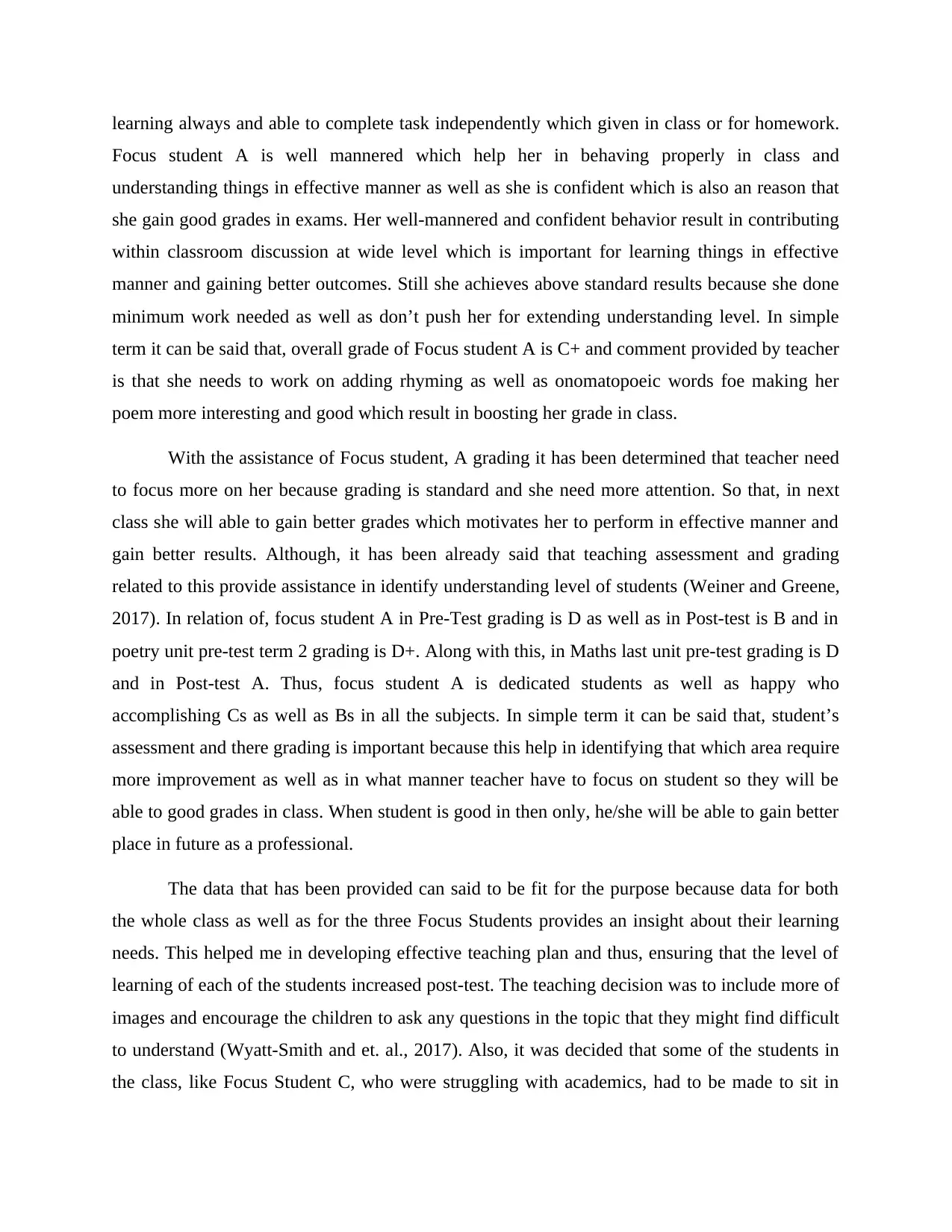
learning always and able to complete task independently which given in class or for homework.
Focus student A is well mannered which help her in behaving properly in class and
understanding things in effective manner as well as she is confident which is also an reason that
she gain good grades in exams. Her well-mannered and confident behavior result in contributing
within classroom discussion at wide level which is important for learning things in effective
manner and gaining better outcomes. Still she achieves above standard results because she done
minimum work needed as well as don’t push her for extending understanding level. In simple
term it can be said that, overall grade of Focus student A is C+ and comment provided by teacher
is that she needs to work on adding rhyming as well as onomatopoeic words foe making her
poem more interesting and good which result in boosting her grade in class.
With the assistance of Focus student, A grading it has been determined that teacher need
to focus more on her because grading is standard and she need more attention. So that, in next
class she will able to gain better grades which motivates her to perform in effective manner and
gain better results. Although, it has been already said that teaching assessment and grading
related to this provide assistance in identify understanding level of students (Weiner and Greene,
2017). In relation of, focus student A in Pre-Test grading is D as well as in Post-test is B and in
poetry unit pre-test term 2 grading is D+. Along with this, in Maths last unit pre-test grading is D
and in Post-test A. Thus, focus student A is dedicated students as well as happy who
accomplishing Cs as well as Bs in all the subjects. In simple term it can be said that, student’s
assessment and there grading is important because this help in identifying that which area require
more improvement as well as in what manner teacher have to focus on student so they will be
able to good grades in class. When student is good in then only, he/she will be able to gain better
place in future as a professional.
The data that has been provided can said to be fit for the purpose because data for both
the whole class as well as for the three Focus Students provides an insight about their learning
needs. This helped me in developing effective teaching plan and thus, ensuring that the level of
learning of each of the students increased post-test. The teaching decision was to include more of
images and encourage the children to ask any questions in the topic that they might find difficult
to understand (Wyatt-Smith and et. al., 2017). Also, it was decided that some of the students in
the class, like Focus Student C, who were struggling with academics, had to be made to sit in
Focus student A is well mannered which help her in behaving properly in class and
understanding things in effective manner as well as she is confident which is also an reason that
she gain good grades in exams. Her well-mannered and confident behavior result in contributing
within classroom discussion at wide level which is important for learning things in effective
manner and gaining better outcomes. Still she achieves above standard results because she done
minimum work needed as well as don’t push her for extending understanding level. In simple
term it can be said that, overall grade of Focus student A is C+ and comment provided by teacher
is that she needs to work on adding rhyming as well as onomatopoeic words foe making her
poem more interesting and good which result in boosting her grade in class.
With the assistance of Focus student, A grading it has been determined that teacher need
to focus more on her because grading is standard and she need more attention. So that, in next
class she will able to gain better grades which motivates her to perform in effective manner and
gain better results. Although, it has been already said that teaching assessment and grading
related to this provide assistance in identify understanding level of students (Weiner and Greene,
2017). In relation of, focus student A in Pre-Test grading is D as well as in Post-test is B and in
poetry unit pre-test term 2 grading is D+. Along with this, in Maths last unit pre-test grading is D
and in Post-test A. Thus, focus student A is dedicated students as well as happy who
accomplishing Cs as well as Bs in all the subjects. In simple term it can be said that, student’s
assessment and there grading is important because this help in identifying that which area require
more improvement as well as in what manner teacher have to focus on student so they will be
able to good grades in class. When student is good in then only, he/she will be able to gain better
place in future as a professional.
The data that has been provided can said to be fit for the purpose because data for both
the whole class as well as for the three Focus Students provides an insight about their learning
needs. This helped me in developing effective teaching plan and thus, ensuring that the level of
learning of each of the students increased post-test. The teaching decision was to include more of
images and encourage the children to ask any questions in the topic that they might find difficult
to understand (Wyatt-Smith and et. al., 2017). Also, it was decided that some of the students in
the class, like Focus Student C, who were struggling with academics, had to be made to sit in
Paraphrase This Document
Need a fresh take? Get an instant paraphrase of this document with our AI Paraphraser
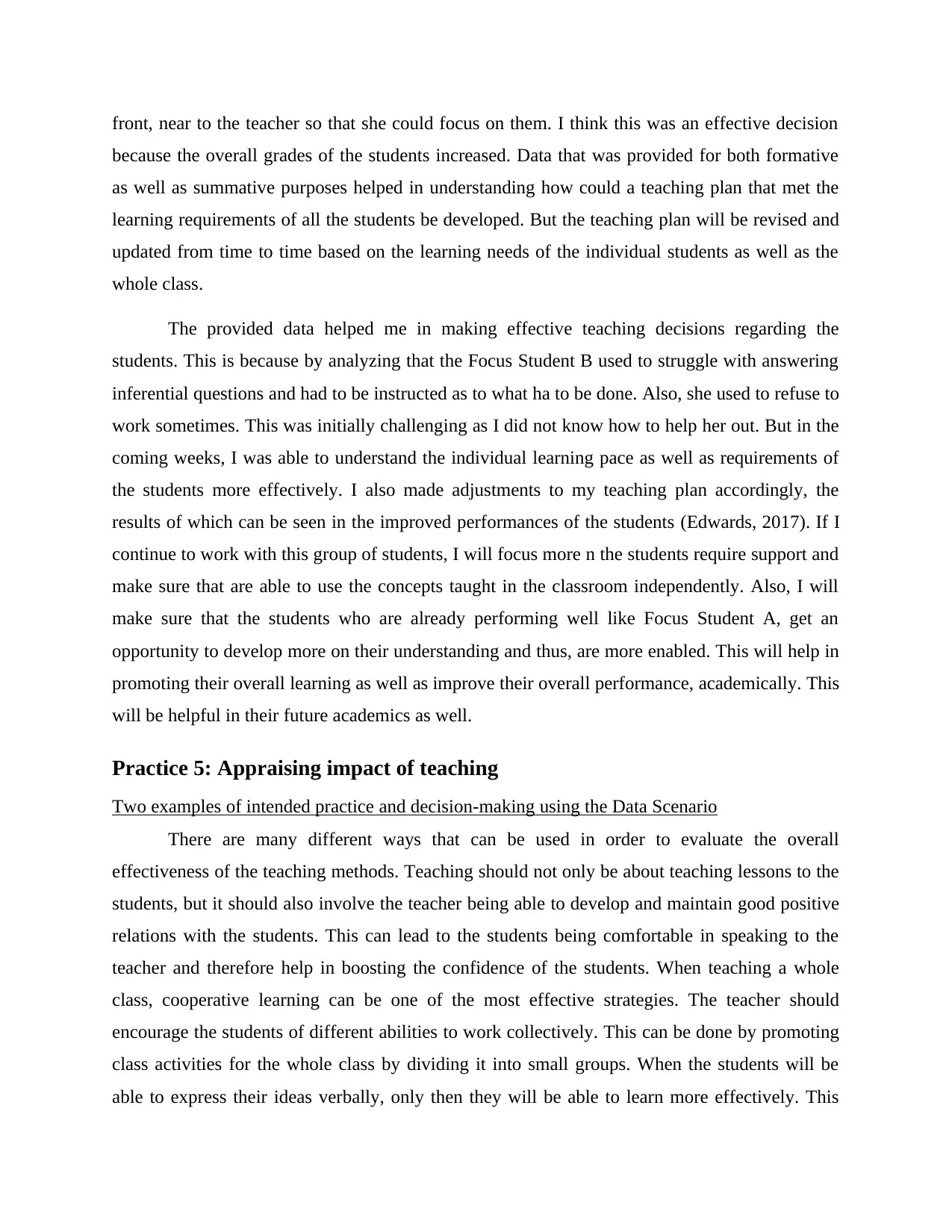
front, near to the teacher so that she could focus on them. I think this was an effective decision
because the overall grades of the students increased. Data that was provided for both formative
as well as summative purposes helped in understanding how could a teaching plan that met the
learning requirements of all the students be developed. But the teaching plan will be revised and
updated from time to time based on the learning needs of the individual students as well as the
whole class.
The provided data helped me in making effective teaching decisions regarding the
students. This is because by analyzing that the Focus Student B used to struggle with answering
inferential questions and had to be instructed as to what ha to be done. Also, she used to refuse to
work sometimes. This was initially challenging as I did not know how to help her out. But in the
coming weeks, I was able to understand the individual learning pace as well as requirements of
the students more effectively. I also made adjustments to my teaching plan accordingly, the
results of which can be seen in the improved performances of the students (Edwards, 2017). If I
continue to work with this group of students, I will focus more n the students require support and
make sure that are able to use the concepts taught in the classroom independently. Also, I will
make sure that the students who are already performing well like Focus Student A, get an
opportunity to develop more on their understanding and thus, are more enabled. This will help in
promoting their overall learning as well as improve their overall performance, academically. This
will be helpful in their future academics as well.
Practice 5: Appraising impact of teaching
Two examples of intended practice and decision-making using the Data Scenario
There are many different ways that can be used in order to evaluate the overall
effectiveness of the teaching methods. Teaching should not only be about teaching lessons to the
students, but it should also involve the teacher being able to develop and maintain good positive
relations with the students. This can lead to the students being comfortable in speaking to the
teacher and therefore help in boosting the confidence of the students. When teaching a whole
class, cooperative learning can be one of the most effective strategies. The teacher should
encourage the students of different abilities to work collectively. This can be done by promoting
class activities for the whole class by dividing it into small groups. When the students will be
able to express their ideas verbally, only then they will be able to learn more effectively. This
because the overall grades of the students increased. Data that was provided for both formative
as well as summative purposes helped in understanding how could a teaching plan that met the
learning requirements of all the students be developed. But the teaching plan will be revised and
updated from time to time based on the learning needs of the individual students as well as the
whole class.
The provided data helped me in making effective teaching decisions regarding the
students. This is because by analyzing that the Focus Student B used to struggle with answering
inferential questions and had to be instructed as to what ha to be done. Also, she used to refuse to
work sometimes. This was initially challenging as I did not know how to help her out. But in the
coming weeks, I was able to understand the individual learning pace as well as requirements of
the students more effectively. I also made adjustments to my teaching plan accordingly, the
results of which can be seen in the improved performances of the students (Edwards, 2017). If I
continue to work with this group of students, I will focus more n the students require support and
make sure that are able to use the concepts taught in the classroom independently. Also, I will
make sure that the students who are already performing well like Focus Student A, get an
opportunity to develop more on their understanding and thus, are more enabled. This will help in
promoting their overall learning as well as improve their overall performance, academically. This
will be helpful in their future academics as well.
Practice 5: Appraising impact of teaching
Two examples of intended practice and decision-making using the Data Scenario
There are many different ways that can be used in order to evaluate the overall
effectiveness of the teaching methods. Teaching should not only be about teaching lessons to the
students, but it should also involve the teacher being able to develop and maintain good positive
relations with the students. This can lead to the students being comfortable in speaking to the
teacher and therefore help in boosting the confidence of the students. When teaching a whole
class, cooperative learning can be one of the most effective strategies. The teacher should
encourage the students of different abilities to work collectively. This can be done by promoting
class activities for the whole class by dividing it into small groups. When the students will be
able to express their ideas verbally, only then they will be able to learn more effectively. This
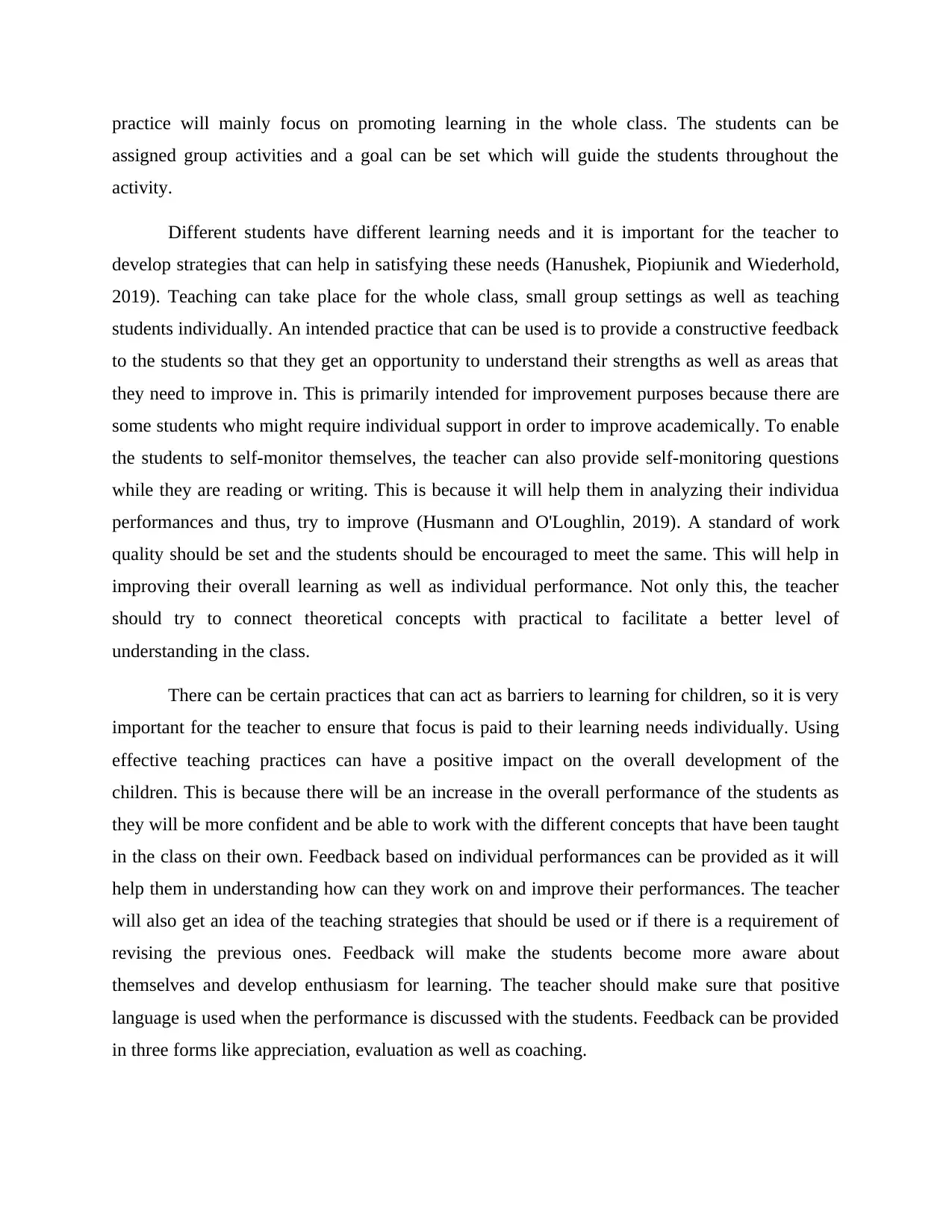
practice will mainly focus on promoting learning in the whole class. The students can be
assigned group activities and a goal can be set which will guide the students throughout the
activity.
Different students have different learning needs and it is important for the teacher to
develop strategies that can help in satisfying these needs (Hanushek, Piopiunik and Wiederhold,
2019). Teaching can take place for the whole class, small group settings as well as teaching
students individually. An intended practice that can be used is to provide a constructive feedback
to the students so that they get an opportunity to understand their strengths as well as areas that
they need to improve in. This is primarily intended for improvement purposes because there are
some students who might require individual support in order to improve academically. To enable
the students to self-monitor themselves, the teacher can also provide self-monitoring questions
while they are reading or writing. This is because it will help them in analyzing their individua
performances and thus, try to improve (Husmann and O'Loughlin, 2019). A standard of work
quality should be set and the students should be encouraged to meet the same. This will help in
improving their overall learning as well as individual performance. Not only this, the teacher
should try to connect theoretical concepts with practical to facilitate a better level of
understanding in the class.
There can be certain practices that can act as barriers to learning for children, so it is very
important for the teacher to ensure that focus is paid to their learning needs individually. Using
effective teaching practices can have a positive impact on the overall development of the
children. This is because there will be an increase in the overall performance of the students as
they will be more confident and be able to work with the different concepts that have been taught
in the class on their own. Feedback based on individual performances can be provided as it will
help them in understanding how can they work on and improve their performances. The teacher
will also get an idea of the teaching strategies that should be used or if there is a requirement of
revising the previous ones. Feedback will make the students become more aware about
themselves and develop enthusiasm for learning. The teacher should make sure that positive
language is used when the performance is discussed with the students. Feedback can be provided
in three forms like appreciation, evaluation as well as coaching.
assigned group activities and a goal can be set which will guide the students throughout the
activity.
Different students have different learning needs and it is important for the teacher to
develop strategies that can help in satisfying these needs (Hanushek, Piopiunik and Wiederhold,
2019). Teaching can take place for the whole class, small group settings as well as teaching
students individually. An intended practice that can be used is to provide a constructive feedback
to the students so that they get an opportunity to understand their strengths as well as areas that
they need to improve in. This is primarily intended for improvement purposes because there are
some students who might require individual support in order to improve academically. To enable
the students to self-monitor themselves, the teacher can also provide self-monitoring questions
while they are reading or writing. This is because it will help them in analyzing their individua
performances and thus, try to improve (Husmann and O'Loughlin, 2019). A standard of work
quality should be set and the students should be encouraged to meet the same. This will help in
improving their overall learning as well as individual performance. Not only this, the teacher
should try to connect theoretical concepts with practical to facilitate a better level of
understanding in the class.
There can be certain practices that can act as barriers to learning for children, so it is very
important for the teacher to ensure that focus is paid to their learning needs individually. Using
effective teaching practices can have a positive impact on the overall development of the
children. This is because there will be an increase in the overall performance of the students as
they will be more confident and be able to work with the different concepts that have been taught
in the class on their own. Feedback based on individual performances can be provided as it will
help them in understanding how can they work on and improve their performances. The teacher
will also get an idea of the teaching strategies that should be used or if there is a requirement of
revising the previous ones. Feedback will make the students become more aware about
themselves and develop enthusiasm for learning. The teacher should make sure that positive
language is used when the performance is discussed with the students. Feedback can be provided
in three forms like appreciation, evaluation as well as coaching.
⊘ This is a preview!⊘
Do you want full access?
Subscribe today to unlock all pages.

Trusted by 1+ million students worldwide
1 out of 16
Related Documents
Your All-in-One AI-Powered Toolkit for Academic Success.
+13062052269
info@desklib.com
Available 24*7 on WhatsApp / Email
![[object Object]](/_next/static/media/star-bottom.7253800d.svg)
Unlock your academic potential
Copyright © 2020–2025 A2Z Services. All Rights Reserved. Developed and managed by ZUCOL.





